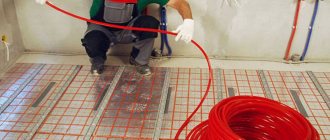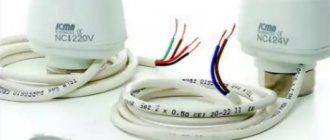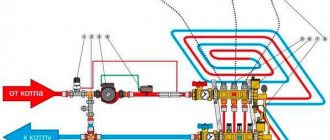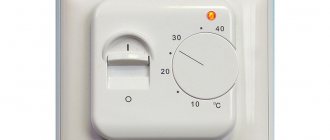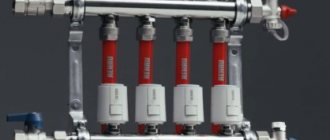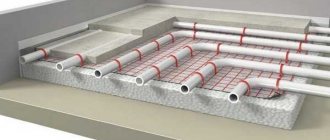When starting to install a heated floor, the question arises which pipe material is better: cross-linked polyethylene or plastic.
The answer lies in the operating conditions of the heated floor, and the opinions of specialists, experience and reviews of people who have been operating floor heating systems for more than one year will help to understand this issue.
Almost all modern pipes are based on cross-linked polyethylene; only metal-plastic pipes have a metal reinforcing layer with adhesive layers added to the outer and inner layers of cross-linked polyethylene, ensuring the solidity of the product.
Cross-linked polyethylene: properties
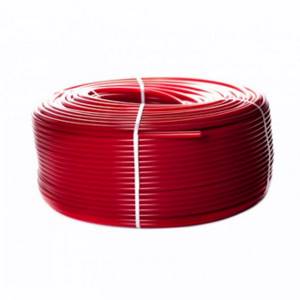
Cross-linked polyethylene is a high-tech material and is a product of ethylene polymerization, which has a network molecular structure with the abbreviation REX.
Conventionally, the crosslinking process consists of creating additional molecular bonds. The original polymer is connected chaotically at the molecular level with free side chains of molecules, forming a three-dimensional network, a particularly strong structure that has a “memory effect.”

Single-layer products are preferable
Changes in the size and shape of the pipe under the influence of loads after they are removed returns the product to its original shape. In terms of technical properties, REX is not inferior to many solid substances and exceeds its service life.
Pipes made of cross-linked polyethylene are produced in 4 ways:
- PE - Ha - peroxide is introduced into polyethylene during the manufacture of the material. The highest degree of crosslinking is 75%. The method has low productivity and high cost of the product, but the material becomes very durable and elastic.
- PE-Xb - treatment with moisture with silane and a catalyst creates polyethylene, from which the shell of the product is less hard, but withstands high pressure when passing liquid. Crosslinking is 65%.
- PEX – s – polymer processed by electrons. Polyethylene with a low degree of cross-linking 55 – 60%.
- PEX – Xd – nitric acid is used. The method is rarely used.
Of the listed methods, the most in demand is a pipe made using silane, which has an optimal price and acceptable performance properties.
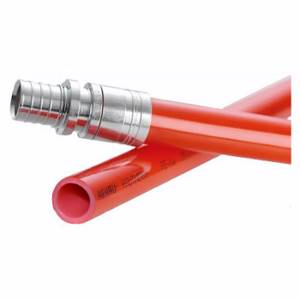
The best option for underfloor heating pipes made of cross-linked polyethylene are single-layer products PE - Xa and PE - Xb with a protective layer that is a barrier to oxygen diffusion, which destroys polyethylene.
Criterias of choice
When choosing a material for the construction of communications, the decisive argument should not be considerations of economic benefit or installation complexity, but the compliance of the technical characteristics of the pipes with the expected operating conditions.
In the case of installing heated floors, the following requirements apply to pipe materials:
The choice of this or that material is also influenced by the type of heating in the house. If this is a central system, then the heated floor will be subject to more severe loads than with an individual circuit.
Note! Those looking for the ideal option for underfloor heating should consider using copper materials. Copper has a much greater safety margin than is necessary in this case. There are two disadvantages - complicated installation and high price of copper pipes.
Metal-plastic and cross-linked polyethylene are very close in their technical and price characteristics. Comparing their positive and negative sides will allow you to make the right choice in each specific case.
Advantages of cross-linked polyethylene products
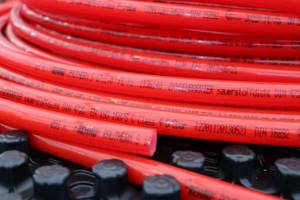
Heating pipes produced by the PE - Xa and PE - Xb methods are characterized by:
- Resistant to pressure changes. In high pressure mode, the service life of the products does not change. The polymer can withstand pressure up to 10 atmospheres.
- Molecular memory. When water freezes in a pipe, the resulting ice increases the diameter of the pipe, and after the ice thaws, the size of the pipe returns to its original size without causing damage to the material.
- Melting and burning at high temperatures. The material melts at temperatures above 150°C and ignites when the ambient temperature reaches 400°C.
- Chemical and biological resistance. Polyethylene pipe is not subject to corrosion, does not create conditions for the appearance of fungi and the proliferation of bacteria, the material is resistant to chlorine and remains neutral to chlorinated water.
- Environmental Safety. When heated, the material does not emit harmful substances and decomposes into carbon dioxide and water when burned.
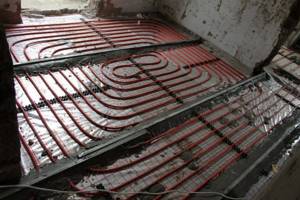
Polyethylene is not afraid of temperature changes - Plastic. When repeatedly bent, the product does not burst and restores its size at the bend.
- Functionality. The polymer material retains its properties, the dimensions of the pipe remain unchanged when the coolant temperature changes from 0 to 95°C, but the material is able to withstand more severe temperature conditions.
Metal-plastic pipe: properties
A metal-plastic pipe consisting of five layers, each of which performs specific functions, also has the advantages of cross-linked polyethylene. The outer and inner layers are polymer, with the outer polyethylene shell protecting against mechanical damage, and the inner smooth layer facilitating rapid fluid flow.
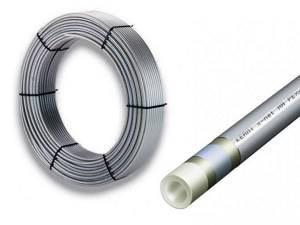
The inner smooth layer does not interfere with water flow
Between the polymer layers there are 2 adhesive layers, and in the middle there is an inner layer - an aluminum shell, which gives rigidity to the entire structure of the metal-plastic product.
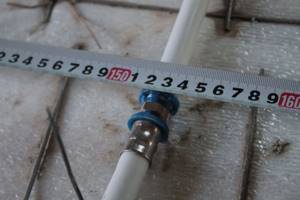
Reliability and durability in operation of metal-plastic products determines the quality of the layers:
- The aluminum layer of the product determines its strength and must be at least 3 mm thick. Technologically, 2 methods of welding the aluminum layer are used, which affect the strength of the pipe, laser butt welding and ultrasonic lap welding. The method of butt welding a layer is called seamless, it does not have the disadvantage of brittleness and, in comparison with overlap welding, does not allow leaks at the joints with fittings.
- The adhesive used determines the possible delamination of the layers when the temperature of the coolant changes, which also affects the strength of the pipe. When using high-quality glue, there is no delamination on the pipe cut.
- The reliability of a pipe is also determined by layers of polymer; polymer marked PEX and PE-RT ensures the strength of the pipe, while pipes with other markings use a low-quality polymer, and in this regard, during a water hammer, this pipe will rupture.
When choosing a metal-plastic pipe, we take into account that these products have a seamless method of welding the aluminum layer, which ensures trouble-free operation of the product.
Pipe connections
Before installing the fitting on metal-plastic, it will need to be calibrated and the chamfer removed. And polyethylene pipes such as PE-RT and PE-X do not require additional preparation for installing fittings. In this case, the pipe must have even cuts.
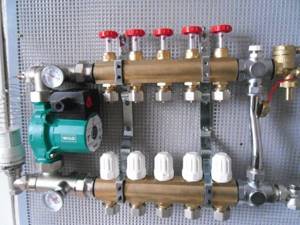
Pipes are distinguished during installation and contour laying. A loop is made from a polyethylene pipe and laid manually. The minimum loop diameter consists of five outer diameters of the pipe. With a pipe diameter of 16 mm, the minimum loop diameter should be 8 cm. For the circuit, these are the most suitable indicators.
Service life at different temperatures
For each material, manufacturers indicate a guaranteed service life of 50 years, provided that it is used for cold water supply. Practice has shown that this is so, and polypropylene (hereinafter referred to as PP) and metal-plastic (hereinafter referred to as MP) work without problems for up to 50 years without leaks in cold water. But with hot water it’s not so simple.
Many PP manufacturers indicate in the product data sheet that the pipes are capable of functioning normally in hot water supply and heating at temperatures not exceeding 70°C. However, in our radiator heating systems the temperature often reaches 80 - 90°C, which naturally reduces the service life of the PCB. When operating in such a temperature regime, the life of the PCB is halved to 20 - 25 years.
In MP pipes, the maximum possible temperature of the pumped liquid, according to the passport data, can be 110°C. However, the service life in such conditions is also 20 - 25 years. From this we conclude that MP beats PP only in the temperature of the liquid with which it can work, and their lifespan is the same. But considering that our heating does not reach 100 - 110 ° C, we can say that PP and MP have the same service life in hot water supply and heating conditions.
What to choose
The answer to this question depends on the criteria that will be a priority for the owner:
- Based on the technical characteristics, we can conclude that for floor insulation in an apartment building it is better to use metal-plastic products - they are more resistant to operation under harsh conditions of pressure and temperature differences.
- When installing it yourself, it is also better to pay a little more for metal-plastic, but make the installation work easier for yourself.
- Cross-linked polyethylene will serve faithfully in an individual home. Even if you forget to drain the water and the system freezes, there will be no problem, the quality of the pipes will not suffer.
- A limited budget with professional skills will also allow you to choose more economical polyethylene.
Both materials are guaranteed to last at least 50 years, withstand the average operating parameters of a heating system on a water circuit well, and do not differ critically in cost.
The underfloor heating system underfloor heating has recently gained great popularity, especially in the construction of new houses. This system was first used in Ancient Rome. The Romans used stone pillars with slabs to create gaps through which warm air could spread. The underfloor heating system offers a complete solution for creating the ideal comfort zone in any conditions.
Pipes are one of the main parts of a heated floor. It is very important that they are of good quality, have ideal technical characteristics, are installed correctly and do not cause problems during further operation.
When installing heated floors, the following types of pipes :
- copper
- steel corrugated
- polypropylene
- metal-plastic
- cross-linked polyethylene pipes
At the moment, the most common are metal-plastic pipes and pipes made of cross-linked polyethylene (REX), in contrast to expensive copper and corrugated steel.
